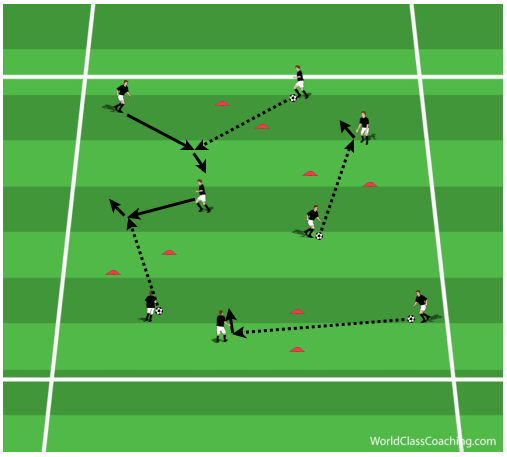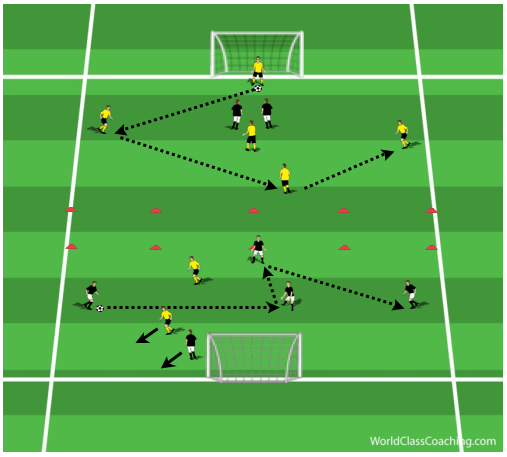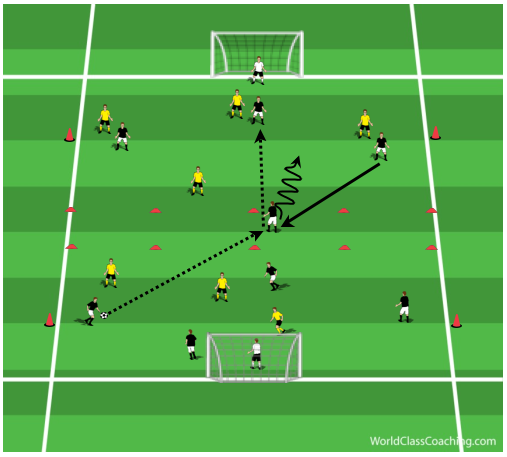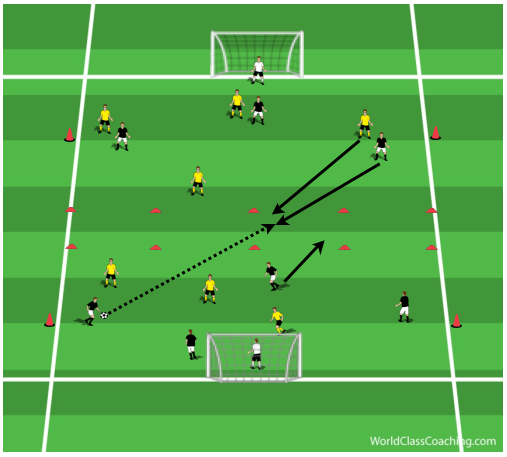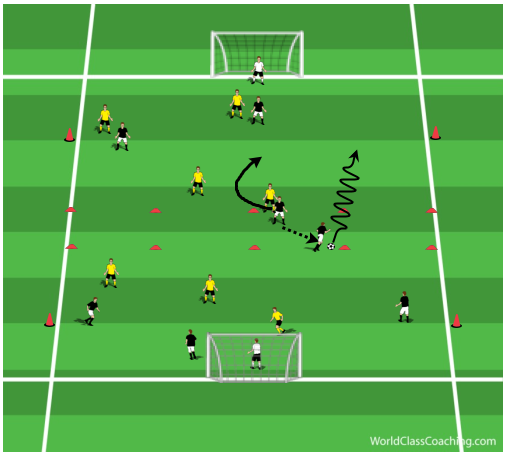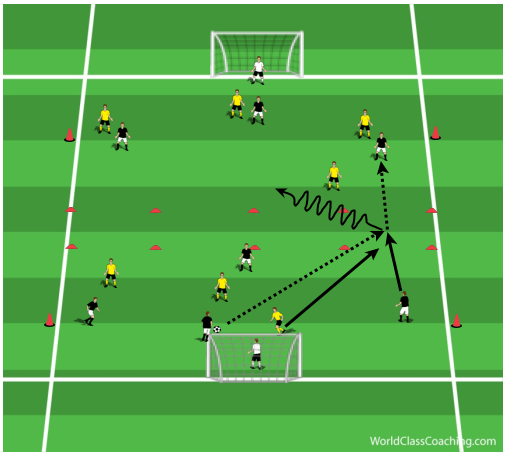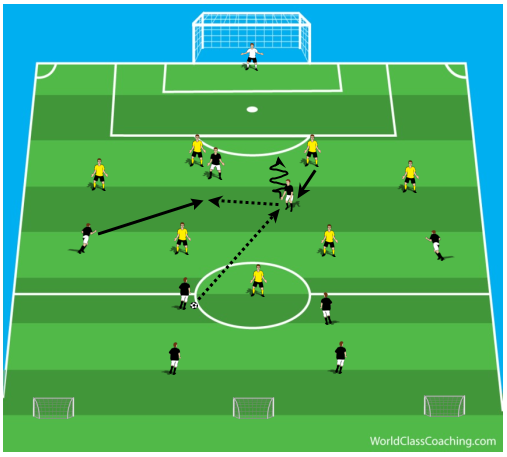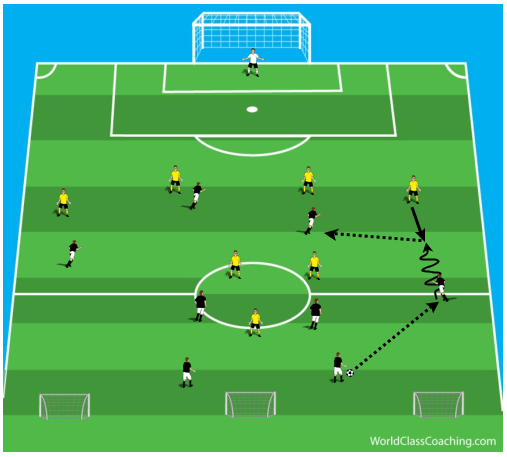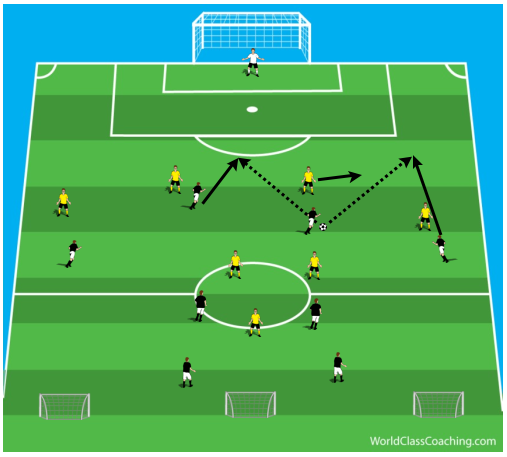By Sean Pearson
This session is purposely detailed to give you, the coach, as much information on why, where and how specific things should happen.
Session Length: 1hr 30mins
Warm-Up Time: 10mins
- In pairs pass through gates. Make sure the pair are 10-15 yards apart when passing.
- Player A passes ball the player B, B takes ball and dribbles, player A finds a new gate, player B passes to player A’s feet through the gate.
- After the players have been going for a minute, introduce body position and receiving on the back foot. Explain how the receiver should have their shoulder facing the ball, NOT the chest. The reason is because, when the chest is facing the ball, every first touch is back in that direction. When your shoulder points to the ball, this opens up the body to a sideways stance and naturally the instep of the back foot (which is the foot furthest from the ball) is now at a different angle and will push the ball forwards, in front of you but at a different angle. Later we will see why this is important.
- Make players aware that it is not just good enough to stand sideways and face the side of the field but the must face in field to see as much as they possibly can. This may mean turning 180 degrees to be in the correct position. You will see players cheat and receive on their front foot because they are being lazy, do not let this happen and reinforce correct body shape.
- Explain that their first touch must not stop the ball underneath them, so their head goes down to see the ball for their second touch, but it should be pushed in front of them so they can make a decision with their second touch.
- Move on to receiving the ball on the move. Here player A passes the ball into the space beyond the gate for player B who is at the side of the gate and can run onto the pass. Again it is important to have your shoulder facing the direction of the passer, to turn your body and receive on your back foot in order to go forwards with your next touch.
- Let your players choose what they want to do.
Technique/Skill Time: 15mins
Here we will work on decision making, when and where to play the penetrating pass to break the lines of the two defenders.
- Set up in a diamond with on player in the middle, this gives lots of natural angles and increases the amount of triangles and diamonds within the formation.
- The aim of the practice is split the two defenders who are aiming win the ball.
- Set goals for both teams, 5 passes is a goal/1 split pass is a goal & for defenders each goal scored is worth 1, first to 3/5/10 wins. The reason a numerical passing target is set, is because this forces the two defenders to win back possession and not just stay together to stop the split. When the defenders win possessions tell them to try to score, this has the added bonus of forcing your team to transition quickly to defending after losing possession.
- It is important for the player in the middle to not follow the ball, stay in the middle and stay behind the two defenders.
- When space between the defenders opens up this is when a split pass can be made. Below we see a movement by a black player, the yellow defender aims to cut this path off, in doing so opens the space between them and the other defender and the split pass is on.
- It is important not to force the split pass and only attempt it when you see the gap appear.
Progression
- Only allow points for one time split passes.
Conditioned Game Time: 25mins
Here you see the arrangement of the area is as before, allowing you to move straight onto this part of the session. The only addition are the 4 cones on each side, I will explain why they are there later.
- Each side sets up with 1 GK, 4 defenders in a diamond, this is so there is depth, and 3 attackers.
- There is a middle zone which is free of players to start with. Only one attacking player from the team in possession can enter the zone. They can be in it for 3 seconds, if they do not receive the ball within this time they must move out of the zone and at least move past the cone on the side. This then allows a different attacker a chance to enter the zone. The reason there is a 3 second limit is if a player were to stand in an area for longer there is a higher change they will be marked.
- Each team is scoring in a direction, when one defense has the ball they are looking to get the ball to the attacking section through a penetrating pass through the lines of the other team.
- As an attacker drops into the zone they alter their body shape so their shoulder faces the ball, they receive on the back foot and with their first touch look to go forward.
- They then make a decision on whether to pass out of the zone or dribble depending on where the space is and where the defenders are.
Progression #1
Now a defender is allowed to follow an attacker into the zone.
- A player from the defensive half is allowed to enter the zone to make a 2v1 scenario.
- This player is determined as to where the space is when the attacker enters the zone. Here we see the right hand side vacated by two players so the player in the defensive half dribbles into this space.
Progression #2
Players from the defensive half of the field can move forward and receive the ball, on the run, inside the zone.
- It is still important that their body shape allows them to take their first touch forward.
- Opposition players can follow them into the zone to apply pressure and keep game realism.
- From there they can continue to dribble or pass, opposition player positioning should determine their decision.
- Below we see this occurring in both the central and wide areas.
Progression #3
Now allow your players freedom to perform all possible options.
Phase of Play: Penetration through the Lines Time: 25mins
8v8 on 2/3rds of field: Attack v Defense - both teams playing a 4-2-3-1 formation.
Have 3 goals at the opposite end for the yellow team to attack and score in.
Continuing on from the message of the previous sections of the session we are looking to penetrate through the lines (midfield & defense) of the opposition. To do this we will use split passes and forward runs, maintaining body shape along the way to assist in effectiveness.
Option 1
- Aim to pass the ball through the midfield with your CMs.
- Your AM should aim to be behind the 2 yellow CMs on a different line than the ST, this is so they can receive the ball in the area between the CMs and CBs.
- When the yellow CMs and AM are spread out this is when the CMs should look to play through them.
- As the ball is passed to the AM, their body shape is side on (shoulder facing the ball, NOT chest). This allows them to have a wider range of vision. They can now see across from them and a defender coming to pressure from behind.
- When the ball arrives to the AM, here is where I give them options. The reason I do this is because if you aim to coach 1 specific pass/play/movement, the defending team will ‘cheat’. By this I mean, because they know what you are aiming to do they will counter it by specifically aiming to stop this happening.
- So to counter act this I give my players 2 options, maybe 3 if they can handle it. This allows them to develop their decision making, depending on the position of the opposition. Giving them too many options will confuse players, keep it simple.
- The two options I give here for my AM are, 1) to use their first touch, with their back foot, to drive forward, this is if a defender does not close down the AM during the pass. At the same time I tell my WM on the side the AM is facing to run inside to support them. Now if the defender closes down my AM they can set the ball with their back foot to this WM, who can continue to drive at the defense.
- Some will say, ‘but using the back foot will allow the defender a greater chance to tackle?’ Yes it will if the AM stays stationary. Encourage you AM to come towards the ball, because of their body position their instep of their back foot will naturally face the direction the WM is running in to. Your AM should also move their back foot towards the ball to decrease the chance of a tackle.
- A third option would be, and I would only point this out and not spend too much time on it and only give it to players who are capable, to aim to slide the ST in between the CBs if one came up to press the AM. For this pass you can be inventive as it is important to allow players to be themselves.
Option 2
- This is when the 3 midfielders begin to stay tight and close together and should force them open again to continue to switch up the direction of your attacks.
- Have your CBs play the ball out to a WM who has dropped down the field.
- Receive side on and look to drive forward
- Tell the WM they need to ‘commit’ the FB by running at them, what you want to happen is for it to draw the FB forward creating space behind them, they are now out of position.
- As the WM gets close to the FB play across to the AM and continue running.
- Now the AM should have a choice of who they play forward to. The continued run from the WM may cause the CB to ‘bite’ and move across. If that happened this leaves more space for the AM to pass to the ST, who should be opposite them so they can play in front of them. If the CB stays central or steps up to pressure the AM this leaves space for the WM to get in behind the defense.
- All passes behind the defense should be played in to space so they do not slow the attack down.
Now encourage your players to use which option is best depending on the positioning of the opposition players, therefore using their intelligence and decision making depending on the scenario presented in front of them.
Game/scrimmage Time: 15mins
Reinforce all points throughout the session:
- Body shape
- Back foot
- Decision Making (when, where, how to penetrate)
By Sean Pearson
By Sean Pearson Sean is also the author Coaching Team Shape in the 3-3-1, Coaching Team Shape in the 4-2-3-1 and Coaching Team Shape in the 4-3-3

